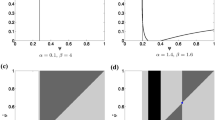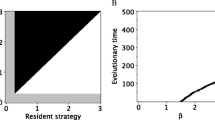Abstract
Models of sexually transmitted infections have become a fixture of mathematical epidemiology. A common attribute of all these models is treating reproduction and mating, and hence pathogen transmission, as uncoupled events. This is fine for humans, for example, where only a tiny fraction of sexual intercourses ends up with having a baby. But it can be a deficiency for animals in which mating and giving birth are tightly coupled, and mating thus mediates both reproduction and pathogen transmission. Here, we model dynamics of sterilizing, sexually transmitted infections in such animals, assuming structural consistency between the processes of reproduction and pathogen transmission. We show that highly sterilizing, sexually transmitted pathogens trigger bistability in the host population. In particular, the host population can end up in two extreme alternative states, disease-free persistence and pathogen-driven extinction, depending on its initial state. Given that sterilizing, sexually transmitted infections that affect animals are abundant, our results might implicate an effective pest control tactic that consists of releasing the corresponding pathogens, possibly after genetically enhancing their sterilization power.



Similar content being viewed by others
References
Anderson, R. M., & May, R. M. (1979). Population biology of infectious diseases. I. Nature, 280, 361–367.
Berec, L., Angulo, E., & Courchamp, F. (2007). Multiple Allee effects and population management. Trends Ecol. Evol., 22, 185–191.
Bessa-Gomes, C., Legendre, S., & Clobert, J. (2004). Allee effects, mating systems and the extinction risk in populations with two sexes. Ecol. Lett., 7, 802–812.
Busenberg, S., & van den Driessche, P. (1990). Analysis of a disease transmission model in a population with varying size. J. Math. Biol., 28, 257–270.
Castillo-Chavez, C., & Huang, W. (1995). The logistic equation revisited: the two-sex case. Math. Biosci., 128, 299–316.
Caswell, H., & Weeks, D. E. (1986). Two-sex models: chaos, extinction, and other dynamic consequences of sex. Am. Nat., 128, 707–735.
Courchamp, F., Berec, L., & Gascoigne, J. (2008). Allee effects in ecology and conservation. Oxford: Oxford Univ. Press.
Dieckmann, U. (2002). Adaptive dynamics of pathogen-host interactions. In U. Dieckmann, J. A. J. Metz, M. W. Sabelis, & K. Sigmund (Eds.), Adaptive dynamics of infectious diseases (pp. 39–59). Cambridge: Cambridge Univ. Press.
Diekmann, O., & Kretzschmar, M. (1991). Patterns in the effects of infectious diseases on population growth. J. Math. Biol., 29, 539–570.
Gao, L. Q., & Hethcote, H. W. (1992). Disease transmission models with density-dependent demographics. J. Math. Biol., 30, 717–731.
Gascoigne, J., Berec, L., Gregory, S., & Courchamp, F. (2009). Dangerously few liaisons: a review of mate-finding Allee effects. Popul. Ecol., 51, 355–372.
Getz, W. M., & Pickering, J. (1983). Epidemic models: thresholds and population regulation. Am. Nat., 121, 892–898.
Hadeler, K. P., Waldstätter, R., & Wörz-Busekros, A. (1988). Models for pair formation in bisexual populations. J. Math. Biol., 26, 635–649.
Hardy, C. M., Hinds, L. A., Kerr, P. J., Lloyd, M. L., Redwood, A. J., Shellam, G. R., & Strive, T. (2006). Biological control of vertebrate pests using virally vectored immunocontraception. J. Reprod. Immunol., 71, 102–111.
Hilker, F. M. (2010). Population collapse to extinction: the catastrophic combination of parasitism and Allee effect. Journal of Biological Dynamics, 4, 86–101.
Hilker, F. M., Langlais, M., & Malchow, H. (2009). The Allee effect and infectious diseases: extinction, multistability, and the (dis-)appearance of oscillations. Am. Nat., 173, 72–88.
Iannelli, M., Martcheva, M., & Milner, F. A. (2005). Gender-structured population modeling. Philadelphia: SIAM.
Jaenike, A. (1996). Suboptimal virulence of an insect-parasitic nematode. Evolution, 50, 2241–2247.
Knell, R. J., & Webberley, K. M. (2004). Sexually transmitted diseases of insects: distribution, evolution, ecology and host behaviour. Biol. Rev., 79, 557–581.
Kokko, H., & Morrell, L. J. (2005). Mate guarding, male attractiveness, and paternity under social monogamy. Behav. Ecol., 16, 724–731.
Kramer, A. M., Dennis, B., Liebhold, A. M., & Drake, J. M. (2009). The evidence for Allee effects. Popul. Ecol., 51, 341–354.
Lindström, J., & Kokko, H. (1998). Sexual reproduction and population dynamics: the role of polygyny and demographic sex differences. Proc. R. Soc. Lond. B, 265, 483–488.
Little, S. (2001). Reproduction and breeding management in cats. Vet. Med., 96, 549–555.
Lockhart, A. B., Thrall, P. H., & Antonovics, J. (1996). Sexually transmitted diseases in animals: ecological and evolutionary implications. Biol. Rev., 71, 415–471.
McCallum, H., Barlow, N., & Hone, J. (2001). How should pathogen transmission be modelled? Trends Ecol. Evol., 16, 295–300.
Miller, T. E. X., & Inouye, B. D. (2011). Confronting two-sex demographic models with data. Ecology, 92, 2141–2151.
Møller, A. P., & Birkhead, T. R. (1992). A pairwise comparative method as illustrated by copulation frequency in birds. Am. Nat., 139, 644–656.
O’Keefe, K. J., & Antonovics, J. (2002). Playing by different rules: the evolution of virulence in sterilizing pathogens. Am. Nat., 159, 597–605.
Parvinen, K. (2005). Evolutionary suicide. Acta Biotheor., 53, 241–264.
Pugliese, A. (1990). Population models for diseases with no recovery. J. Math. Biol., 28, 65–82.
Rankin, D. J., & Kokko, H. (2007). Do males matter? The role of males in population dynamics. Oikos, 116, 335–348.
Shuster, S. M., & Wade, M. J. (2003). Mating systems and strategies. Princeton: Princeton Univ. Press.
Sloan, D. B., Giraud, T., & Hood, M. E. (2008). Maximized virulence in a sterilizing pathogen: the anther-smut fungus and its co-evolved hosts. J. Evol. Biol., 21, 1544–1554.
Thrall, P. H., & Antonovics, J. (1997). Polymorphism in sexual versus non-sexual disease transmission. Proc. R. Soc. Lond. B, 264, 581–587.
Tobin, P. C., Robinet, C., Johnson, D. M., Whitmire, S. L., Bjørnstad O. N., & Liebhold, A. M. (2009). The role of Allee effects in gypsy moth, Lymantria dispar (L.), invasions. Popul. Ecol., 51, 373–384.
Vynnycky, E., & White, R. G. (2010). An introduction to infectious disease modelling. Oxford: Oxford Univ. Press.
Acknowledgements
This work was assisted by attendance as a Short-term Visitor at the National Institute for Mathematical and Biological Synthesis, an Institute sponsored by the National Science Foundation, the US Department of Homeland Security, and the US Department of Agriculture through the NSF Award #EF-0832858, with additional support from The University of Tennessee, Knoxville. LB acknowledges funding from the Institute of Entomology (Z50070508). D.M. acknowledges funding from Wheat Ridge Ministries—O.P. Kretzmann Grant for Research in the Healing Arts and Sciences. The authors wish to thank the two reviewers for their detailed and helpful reports that improved the exposition of this paper.
Author information
Authors and Affiliations
Corresponding author
Rights and permissions
About this article
Cite this article
Berec, L., Maxin, D. Fatal or Harmless: Extreme Bistability Induced by Sterilizing, Sexually Transmitted Pathogens. Bull Math Biol 75, 258–273 (2013). https://doi.org/10.1007/s11538-012-9802-5
Received:
Accepted:
Published:
Issue Date:
DOI: https://doi.org/10.1007/s11538-012-9802-5




